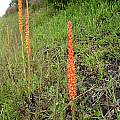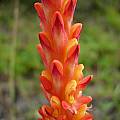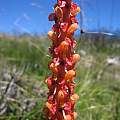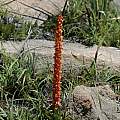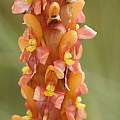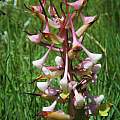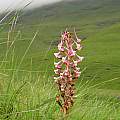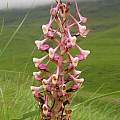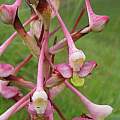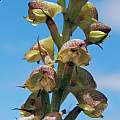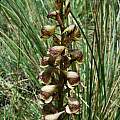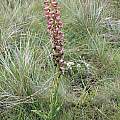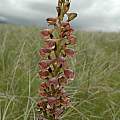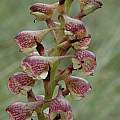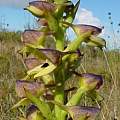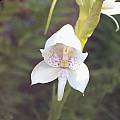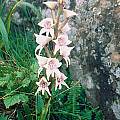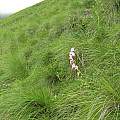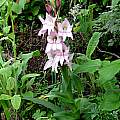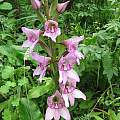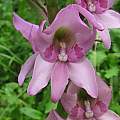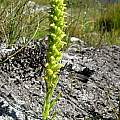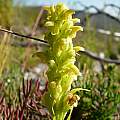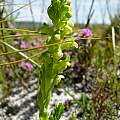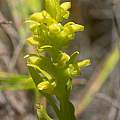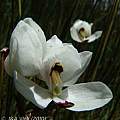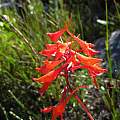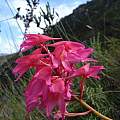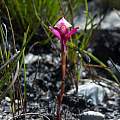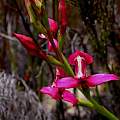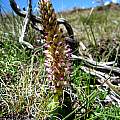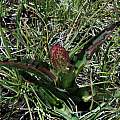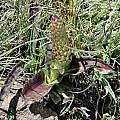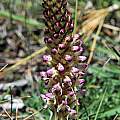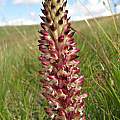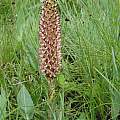Disa is a genus in the family Orchidaceae and is mostly found in southern and eastern Africa. Species are deciduous or evergreen terrestrial plants with both tuberous and stoloniferous root systems. They are found from sea level to about 7000 feet. Species ch-f are found on this page.
Disa species a-ce - Disa species g-n - Disa species o-r - Disa species s-z - Disa index
Disa chrysostachya Sw. is a species found in damp grassland and marshy areas from Knysna to Mpumalanga. It is known as the red or yellow torch orchid and has a spike-like inflorescence of densely-packed yellow to red or pink flowers. Height range: 25-100 cm. Photos #1-3 by Cameron McMaster. Photo #4-5 by Bob Rutemoeller. Photo 6 from Christopher Whitehouse. The last four were taken at Gaika's Kop January 2010 and January 2012.
Disa cooperi Rchb.f. is found on stony mountain grassland from 1500 to 2200 meters in the Drakensberg Mountains. It grows to 1 meter and has pink flowers with a lime-green lip in a dense spike. Flowers are intensely fragrant. Photos 1-3 taken by Mary Sue Ittner January 2010 near Maclear. Photos 3-6 taken by Cameron McMaster, Aurora Peak, Maclear, February 2008.
Disa cornuta (L.) Sw. is found in damp but well-drained grassland up to 2400 meters from the Western Cape to Zimbabwe. It grows to 1 m tall and has overlapping crowded leaves. The basal ones are purple-spotted. Flowers are in a dense inflorescence and purple and silvery green. The lateral sepals and lip are greenish yellow. The first five photos were taken January 2010 near Maclear by Mary Sue Ittner and Bob Rutemoeller. The last photo below from the book Plants of the Klein Karoo is courtesy of Jan and Anne Lise Schutte-Vlok.
Disa crassicornis Lindl., a deciduous species found in damp grassland, or forest margins and rock ledges in the Eastern Cape, Transkei, Lesotho and KwaZulu-Natal, is summer growing. It has large sweetly-scented white to cream flowers with purple or pink markings. It is a very attractive species, but difficult to cultivate. Height range: 2-3 ft. tall. Photos by Cameron McMaster. Photo 2 was taken at Mt. Kubusie in the Amatola Mountains of the Eastern Cape. Photos 3-6 were taken at Aurora Peak, Maclear, February 2008.
Disa cylindrica (Thunb.) Sw. is species that grows from 7 to 34 cm and has yellow-green flowers that are almost spurless and blooms after fire. It is found in seeps or damp sandstone slopes from the western Cape to the Eastern Cape (Tulbagh to Cape Peninsula to Humansdorp.) The first three photos by Cameron McMaster were taken near Napier in the Overberg. Fourth photo by Christopher Whitehouse, taken at Phillipskop Mountain Reserve near Stanford.
Disa elegans Sond. ex Rchb.f. grows to 60 cm when it is in flower (only after fire.) Flowers are white with the lip and inner petals marked with maroon-purple. Plants grow in wet peaty soils from the Cedarberg to the Swartberg Mountains. Photo and text from the book Plants of the Klein Karoo is courtesy of Jan and Anne Lise Schutte-Vlok.
Disa ferruginea Sw. is a species from the Southwestern Cape where it grows on sandstone slopes from 750 to 1350 m. Growing to 45 cm, it has many grass-like leaves that are dry at flowering and crowded racemes of bright red to orange flowers in late summer. Flowers resemble nectar producing Tritoniopsis triticea flowers in an attempt to attract Aeropetes tulbaghia, the Table Mountain Pride butterfly. The Disa ferruginea flowers do not produce nectar. The first photo from Cameron McMaster was taken at Boskloof. The second photo is from Jan and Anne Lise Schutte-Vlok.
Disa filicornis is a small species that grows on mountain slopes in the winter rainfall region. It blooms spring to summer. An article by S.D. Johnson reported that the species is pollinated by male mason bees. Since the flowers do not have nectar, the author speculated that the flowers may fool the bees by resembling other plants that do have nectar, or they may mimic female mason bees. Height: 60 cm. The first photo was taken by Christopher Whitehouse at Phillipskop Mountain Reserve near Stanford. The last photo from the book Plants of the Klein Karoo courtesy of Jan and Anne Lise Schutte-Vlok.
Disa fragrans Schltr. is found on mountain grassland, on rock sheets, around rock pools and on cliff ledges from 1800 to 3000 m from the Eastern Cape to Tanzania. Leaves can have purplish red spots or bars. Flowers are small, white to deep pink, mottled darker pink. Height range: 30-60 cm. Photos by Cameron McMaster, Bob Rutemoeller and Mary Sue Ittner taken January 2010 at Naude's Nek. Photos 5-6 were taken by Cameron McMaster at Mafika-Lisiu Pass in Lesotho and at Sentinel Peak in the Eastern Cape.
Disa species a-ce - Disa species g-n - Disa species o-r - Disa species s-z - Disa index
